
Another person who would play a crucial role in Dan's
future was Matt Umanov
who at an early age was already a master luthier. Matt had an interest in instrument repair as early as age 12 or 13.
Here he can be seen with family & friends in the summer of 1950 at his third birthday party, though Matt could not
identify the man & woman in the bathing suits.
photographs courtesy of Matt Umanov
His present - a ukulele. Matt goes on to describe the photos - from left to right stating "Some classic guitar
inspection poses; #1 is sneak in a slight whack, test its mettle. # 2 my fav, now let's see what we have here,
take in the whole picture. Still use that same focus. Amazing. # 3 look down the neck (even at that age, apparently
I knew which end to look from."
Those that know Matt well inform him that the look on his face in these photos is the same look he still gets today
whenever he picks up a new instrument that he really likes. A born New Yorker, Matt would eventually come to ply his
trade in the same city as Dan.
While Matt & Dan both did guitar repair work, they usually had different clientele, and at this at point in time Matt's
name may have been much better known throughout the New York guitar community in general than Dan's. Whereas Dan was
in the electric guitar modification business; Matt was the 'go-to guy' for more major guitar repairs of all sorts, from
19th-century Martins that had literally gotten sat on - to Les Paul's with broken peg heads or truss rods.
In fact, it was just this sort of repair that led to their first meeting. According to Matt Umanov "Dan had a Les
Paul Custom with a broken truss rod, and also Eric Clapton had come to him with a Les Paul with a hopelessly broken
peghead, and Dan really didn't know how to deal with either of these situations. Literally everyone he talked to about
the repairs told him to come to me, and so he did."
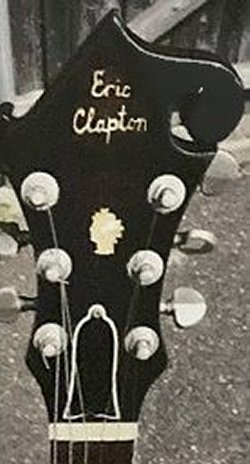
|
Matt continues stating "Eric Clapton's guitar was a late 50's Les Paul Custom with a headstock that had been
totally broken off. Dan's asked me to repair it, and asked me to make something different."
"When I asked what he wanted, and Dan said, 'basically, anything you want, whatever you think is good'. So, I made a scrolled type
headstock, much like a Gibson F5 Mandolin headstock."
"I decided to use mother-of-pearl inlay on the peghead, and put in the name Eric Clapton in a script-type lettering. Eric was
delighted with his new and personalized instrument. I still have a few interesting remnants from that
Eric Clapton repair job, done around 1967."
Seen at left is Eric Clapton's customized headstock. Photo is courtesy of Matt Umanov.
|
With five children under her wing, Dan's first wife Donna needed some help and so the two oldest boys - Kent and Eric - went to live with their
grandfather who was a designer of industrial type ovens and lived in Cleveland. Later, in 1968 the boys lived in New York with Dan and Cynthia.
Above left, Dan playing what might be a 1967 Epiphone Rivoli EB-232C bass guitar, probably in 1969 and equally likely in his shop at 500
LaGuardia Place in Greenwich Village. My first guess was a Gibson EB2-DC model which the EB-232C is copied after, but the top of the
headstock, though somewhat out of focus looks to have a much longer name than 'Gibson' written across it. As Cynthia's niece stated
"notice the ubiquitous pack of cigarettes in Dan's shirt pocket." Also notice the Marshall amp head and angle cabinet which has
what many call the 'salt & pepper' style grille cloth, which would be correct for the 1969 time frame. The existance of the Marshall
stack is why I believe that this photo was taken at Dan's guitar store.
At right, Dan's wife Cynthia talking on the phone. Likely this was also taken in 1967-69 time frame. Notice what today would be a very
oversized telephone surrounded by a great many paper notes, suggesting a business phone. In addition to the phone her striped pants are a
testament to the time frame.
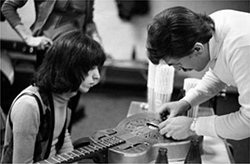
|
At left, Dan Armstrong backstage with Rolling Stones bassist Bill Wyman at Madison Square Garden in 1969. It appears as though Dan
is fixing or maybe re-stringing a Dobro instrument of some make while Bill looks on. Photo courtesy of Laurent Steen.
|
In 1969 Dan was visited by representatives of Ampeg and as a result of this visit
he ended up in a contract with them to design and build a new line of electric guitars and basses. These instruments were made of clear acrylic and
because of the excellent and pleasing work he had done for Dan in the past, Dan turned to none other than Matt Umanov to hand build the prototype
guitar and bass bodies and necks, while Dan enlisted Bill Lawrence, a master pickup designer to help Dan design a unique new style of guitar pickup
that had not been produced before.
Once the clear acrylic models were introduced, eight prototypes were made using different materials (and color) but according to Dan "it didn't
work out" - and so production of those models were discontinued and production continued using the original materials and only the clear models
continued to be produced. More about this can be read in the guitar section.
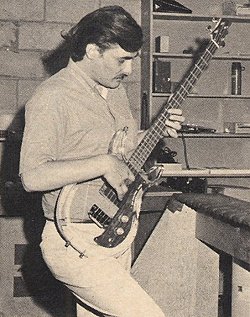
|
At left, Dan Armstrong personally checks out a newly made Dan Armstrong · Ampeg bass in 1969. The date is identified by the pickup plate seen
holding the pickup in place which was only on the earliest models. Part of the agreement between Dan and Ampeg was that he would personally check out every instrument
before it left the factory.
It is believed that this photo was taken at the Ampeg factory as there is an Ampeg box behind Dan in the shadows stamped with the (then) Ampeg name on it. The distinctive
letter 'A' can just be made out. More on this photo can be seen and read in the Brochures section.
Dan was brought into the Ampeg fold by
Everett Hull, founder of the company, and on his early visits to Ampeg he was usually accompanied around by Mr. Roger Cox, but as time went on
this changed and he no longer needed to be accompanied.
|
Dan also figured that since he was making instruments for Ampeg, that it would be good diplomacy to start carrying the Ampeg line of amplifiers in
his store. Unfortunately Ampeg amps didn't seem to sell as well as other amplifier brands. Musicians seemed to be looking for a new & different
sound than what Ampeg could deliver. Steve Kubica remembers "The Ampeg bass amps would sell ok, but the guitar amps just stayed there forever.
We were often flooding in Ampeg amps and as time went on I think they tried paying Dan's guitar royalities with amplifiers, rather than cash. There
were so many of these amps in the store which had a rickety old floor to begin with, and I often wondered when it would crash through."
Steve goes on, adding "We could move the Fender amps fairly quickly, and Marshall amps sold very well, but the Ampeg guitar amps would just
gather dust." In order to try to move some of these amps Dan enlisted the help of an electronics tech by the name of Tom Duffy and together
they began to experiment by changing compoments and modifying the Ampeg amplifiers that we had at the store. Dan stated "Basically, we hotted
them up." According to Steve "It wasn't very long before Ampeg wanted to know more about his modifications as well as any other ideas and
designs they had."
Because of his (then) new association with Ampeg, Dan sent them schematics of his modifications in good faith, no doubt assuming royalty
compensation would follow in time. "The number one priority was to get musicians the sounds they wanted. Everything else could be worked out
after that. I even went so far as to help out in the amplifier line right at the Ampeg factory" Dan once said as he described his visits to
Ampeg.
Hank, from California, writes in stating "I was there when Dan came up with the idea for the SVT. One day Mr. Bob Rufkahr, Sales Manager for
Ampeg and later Vice President of Marketing, approached Dan as they wanted to market an amplifier that would compete against the Acoustic 361- which
was a powered cabinet with an 18" Cerwin Vega loudspeaker inside, rear mounted with a folded horn. Dan knew of Peter Traynor's work up in Canada and
suggested that Ampeg build something similar to one of their bass amps, most notably like the Traynor YBA-3 Custom Super Special bass amp."
So the word was given, and once again Dan was asked to help. This time to design an amplifier that could compete in this market. Eventually Dan came
up with the circuit design for what would become the Ampeg SVT (Super Valve Technology) amplifier and, according to Hank, "obviously changed the
course of bass playing for the world...and perhaps Dan's greatest contribution of all - and in doing so, he single-handedly handed Ampeg the
position they are in today. Despite all this, he never received any credit or compensation for the SVT concept".
According to the book Ampeg - The Story Behind The Sound - by Gregg Hopkins & Bill Moore, accounts of the V series amplifiers somewhat differ,
stating in their book "other Ampeg designers remember it as a more collaborative effort. Danny, Rich Mandella, Roger Cox and I developed the V
series of amplification" recalled Bob Rufkahr in that book. But like Hank, Steve Constantelos, a former Ampeg engineer remembered Dan - and
stated "I knew Dan well - he was a very nice man and a designing genius. Ampeg's chief engineer Bill Hughes and I worked closely, day and night
designing the SVT and V series amps but a lot of this was built around Dan's designs." With all the differing opinions of past engineers and
management at Ampeg - it begs the question.... what's the truth?
In the end, it's hard not to be impressed with the logic of Jimmy Ryan - then the store manager for Dan Armstrong Guitars who stated "During the
late sixties, Ampeg was losing ground to Fender, Marshall, Traynor and other amp makers where they once led the industry. They wanted to remain
relevant, but their current stable of underpowered B-15s and Reverberockets proved useless for big stage productions despite their popularity in
studios. Dan Armstrong loved Traynors, and in an offer to help Ampeg survive, urged them to create a similar, more attractive line of amps. He gave
them very specific ideas - Traynor-inspired configurations - 4 x12 speaker cabinets for guitars and 8 x10 cabinets for bass.
He suggested high-wattage power amps with lightening transient response for chunky guitars and punchy bass, and smoother, better-sounding eq curves
that would help guitars and basses cut through the noise. Over several months they experimented with circuit designs, amp to cabinet configurations,
colors, front panel look, etc., and when all agreed on the ultimate schematics, production kicked in and out came the SVT line… with Dan’s name
nowhere to be found on the final product. Technically, he was a consultant, not an official member of the design team, but still… not a mention for
all his work? I don’t know if Dan ever protested, but his bitter disappointment was no secret.
We showcased some of the first lot in the store, but to our surprise and dismay, they didn’t sell. Peculiar, because musicians came in, played them,
loved them, and left without buying. To solve this annoying conundrum, I made a reconnaissance run up to 48th Street. Retail espionage? Yep, guilty
as charged. Manny’s was selling SVT amps at our cost. Musicians would come to our store to try them out, then taxi up to 48th Street and buy them.
While all musical instrument dealers could purchase their inventory at 50% of list price, Manny’s got special treatment. With the number of units
they bought, they received an additional 10% discount plus an extra 5% for unusually large orders. The retail jargon for this little blessing was
fifty, ten, and five. Hence, they could sell them at our cost and still make a potential 15% profit. Our little Greenwich Village shop, a tiny store
by comparison, couldn’t afford to buy ten, let alone twenty units at a time. To be in the SVT business, we’d have to sell units at zero profit, then
lose money on the shipping. Maybe OPEC could survive on that kind of business model, but not our little store. Dan begged them to give us at least
the additional 10% discount using his designer credentials as a bargaining chip, but they refused. Manny’s moved a significant volume of products,
and Ampeg didn’t want to risk disturbing that profitable relationship to appease Dan Armstrong Guitars.
In their myopic view, we were an insignificant player. Dan, shackled to a contract for the already-in-production lucite guitars, had to face up to
the fact that his appeals and pressure tactics were about as threatening as a water pistol in a tank fight. Ampeg’s short-sighted posturing lit the
fuse on the Armstrong/Ampeg partnership, and things deteriorated rapidly. To add spice to the heartburn, I soon gave notice, quit the store, and set
out to pursue a career as a studio musician. I never meant to be part of the problem, but I also never meant to be a career store keeper.
Eventually, Dan Armstrong Guitars became insolvent, closing its doors forever, and Dan moved to England, leaving it all behind. Though we lost a
year in the interim, he and I resumed our friendship when I moved to London. Strange as it may seem, we never discussed what happened between him
and Ampeg, nor why the store didn’t survive. I can only imagine how painful those events were for him. Though we often talked about his guitars and
amp designs, he never mentioned Ampeg again. I felt it was best to follow suit."
So while the V series amplifiers may or may not have been a 'collaborative effort' one thing that definitely was not shared was the monetary
compensation thereof - at least for Dan - and it is here, I think, where the relationship between Dan Armstrong and the Ampeg Co. began to unravel,
for while all the other engineers received a paycheck for their time and efforts - and major music stores got great deals when buying these new and
highly desirable amps from Ampeg, all Dan received was Ampeg's 'Thanks' for all the time and efforts he put forth, to say nothing of the schematics
he readily shared with them. Top it all off with his inability to even acquire these amps at a reasonable price to sell, and it should come as no
surprise that Dan felt both used and betrayed, and it would only be a matter of time before he would choose to sever his ties with the Ampeg
Company.
Dan soon began to be absent from the store as he took time off and headed to the west coast where he helped his old friend
Neil Diamond who had reportedly set up a guitar factory. Back at Dan's
store, extra help was needed and as Carl states, "towards the end days, there seemed to be a big turnover of employees going through Dan's shop
for some reason."
One of the 'turnovers' was Steve Kubica who had become very frustrated with the lack of Dan being there. "Sometimes Dan would only stop in the
shop twice in a week. On a good week it was three times. Musicians would be calling asking for him and we didn't know what to tell them after
awhile. There were some awaiting repairs and we could not repair them, as we had to wait for Dan's advice on something. Others wanted to trade in
their guitars, and we had to put them on hold as well until we could talk with Dan. Here he built this tremendous business up by doing great repair
work and then he just let it fall by the wayside. It's like he just dropped the ball or something." However, it should be remembered that Dan
was busy playing gigs all over, as well as doing session work and if anything, he probably just made the mistake of spreading his time a little too
thin. Coupled with his disappointment with Ampeg, he may have just been losing interest overall, and getting ready to sever his ties with them and
move on.
Whatever the reasons, the result was disastrous, and Steve waited for the right moment to approach Dan. "When I finally told Dan I was quitting
he looked really hurt as I think he thought I, or someone should be running the store. I then said 'but we can still be friends, can't we?' and Dan
was taken aback by this for a brief moment, then smiled, patted me on the back and said 'of course we are - it's probably for the best anyway'."
Unknown to Steve and Dan, their paths would cross again in the future.
Not long after Steve left, Jimmy Ryan entered Dan's orbit. He was in no way a stranger as Dan helped Jimmy out when he was in a band called
The Critters - a mid 60's band that enjoyed
success with major hits such as 'Mr. Dieingly Sad' and 'Younger Girl'. In Jimmy's book
Behind - he
states "After a gig at Ruters University a thief stole our instruments and amps so we went to Dan Armstrong for replacements. Through some
unexpected twists and turns, Dan ended up being the producer of our third album in 1969."
Above left is the album cover of the 1969 Critters album that Dan had produced. Being rather unique looking, and over the phone I asked Jimmy about
the art on the cover to which he replied "I think the artist wanted to do Salvador Dali type artwork on the cover."
On the right, the back side of the album shows the band members, top to bottom - left to right: Jimmy Ryan, Paul Glanz, Jeff Pelosi and Kenny Gorka.
Below the Critters name, Dan Armstrong is listed as producer. In an interview with Jimmy Ryan by Gary James - Jimmy states "While we were mixing
Dan said, 'I want to bring my girlfriend by. She's a singer. You'll like her.' It was Carly Simon. That was his girlfriend. At the time Carly was
his secretary, living with her sister, sleeping on the couch."
In an interview with Jimmy Ryan by Gary James - Jimmy said "When The Critters broke up, I called Dan. He had a guitar store in New York. I said,
'Do you need anybody to work in your store?' He said, 'Actually, I need a store manager. Wanna do it?' I said, 'Absolutely.' So I worked in his
store for about a year. Dan also became famous as a guitar designer, making those clear plastic guitars. That was his guitar. I worked with him on
that".
After reading that last sentence I had to ask Jimmy how he got involved with the acrylic prototype guitar and he replied "When I saw the
prototype I made a number of suggestions. I hated the one pickup design and told him so. It relegated the guitar to the sound of a Les Paul Jr. I
liked two or three pickups but my suggestion fell on deaf ears. I was a Gibson 335 owner and loved the precision of the tune-o-matic bridge. The DA
guitar had tuning problems, and I suspect that little strip of wood bridge was the reason. You could get it in tune in the lower range, but the
upper range would be out. Again, Dan was stubborn and held his ground. As a compromise, I convinced him to put a fret in the wood bridge to help
brighten the tone, and increase the sustain. That, he agreed to do. With those suggestions, my contribution was complete."
1970 found the acrylic instruments and V series amplifiers well into production at Ampeg, and with studio sessions increasing, Dan found himself
even busier than before. Carl Thompson went on to say "Once Dan got into negotiations with Ampeg, we started to see less and less of him in the
shop. It got to a point where Dan even had me doing the administrative part of the business, making the bank deposits, and doing payroll. To the
best of my knowledge, I don't think I messed anything up, but I don't think the books were being done in exactly the same way as before because
Dan never showed me the conventions he used, so I had to more/less use my own conventions". Dan's lawyer Mort Smiley did the taxes for Dan
while he was away.
In an interview with Jimmy Ryan by Gary James - Jimmy said "During that year" [working for Dan] "Carly and I became very close friends.
We double-dated with my girlfriend, Dan and her, and hung out and sang songs in the store after hours - Beatles songs or someone else’s. We actually
did a couple of jingles together. She started her career as a jingle single singer, But then she started writing and she started writing with a
vengeance. Really, really good stuff."
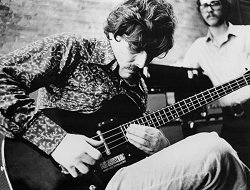
|
Danny playing a Dan Armstrong Modified Danelectro bass at his LaGuardia Place shop. Photo taken by Cynthia Armstrong's close friend
Jimmye E. Kimmey. Being Dan is playing one of his Modified Danelectro basses dates this photo to sometime in 1970.
In the background is Jimmy Ryan, who managed the store for Dan and played with The Critters and Carly Simon. Photo and text are courtesy of
Cynthia Armstrong's loving niece. More about these instruments can be read in the Danelectro section.
|
Jimmy talks about his time at Dan's store, stating "Working for Dan I learned a lot of techniques by watching players that came into the store.
For example, Leslie West of Mountain showed me how to play pinch harmonics." Jimmy also mentioned how many of the stars visited Dan's store.
In one conversation he made mention of The Lovin’ Spoonful's John Sebastian..... stating "I think he lived nearby as he was in the
store almost everyday."
As to working at Dan's store, Jimmy said "Working there had been an income stopgap - never a permanent position. I was itching to leave as soon as I
could start earning as a studio musician. I had been working in the pit band for the Broadway production of
Hair, earning some decent money, and had been doing some
commercials with Carly, and I just felt it was time. I formed the band Ivory, which was the precursor to Carly’s first band.
That would put my departure at Dan's store somewhere in late winter to spring of 1970. There were no hard feelings on Dan’s or my part, as
we always knew my future was not in retail. It was a temporary job at best. Dave Rennie was more than happy to take over my job and finding him an
assistant was no big deal."
I then asked Jimmy how much time lapsed between leaving Dan's store and working with Carly Simon to which he replied
"My first intro to her writing was when she played me the already recorded, 'That’s The Way I’ve Always Heard It Should Be' and that came after
she asked me to play on the remainder of that first album months after she and Dan split up and I left the store. The dates are now starting to
look iffy as I just looked up when she recorded her first album. It was 1970-71, so the gap between when I left the store and when she and I
actively started working together might have been wider than I imagined. I thought around six months, but it may have been more like a year."
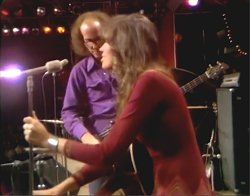
|
At left, Jimmy Ryan on bass and Carly Simon singing her hit song Anticipation at Central Park during the 1971 Schaefer Festival
which they called, “Good Vibrations in Central Park." The concert was filmed for an ABC-TV special.
Notice that Jimmy is playing his Dan Armstrong clear bass.
More about Jimmy, Dan Armstrong, and this bass can be read in his book
Superstar. Photo courtesy of Jimmy Ryan.
|
continue
menu
Names and images are TMand © Dan Armstrong / Ampeg. All rights reserved.
All other names and images are TMand © of their respective owners. All rights reserved.
|
| |

